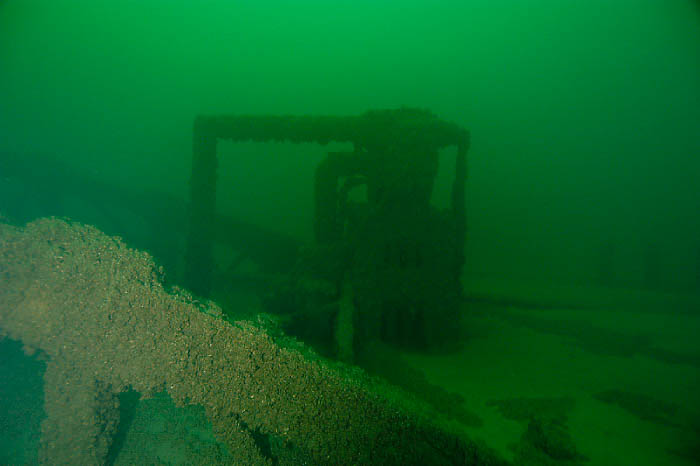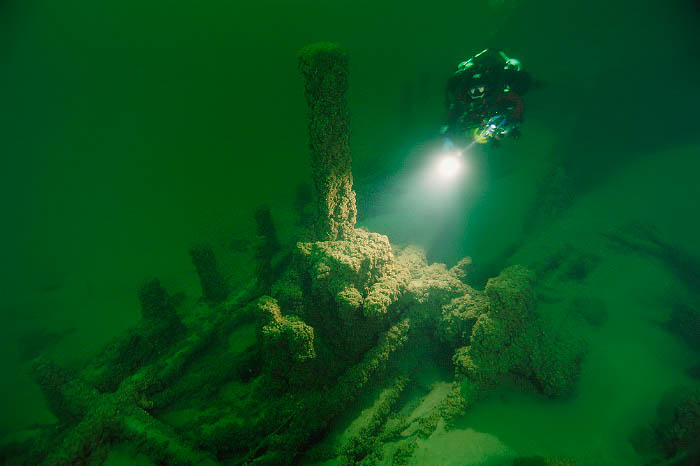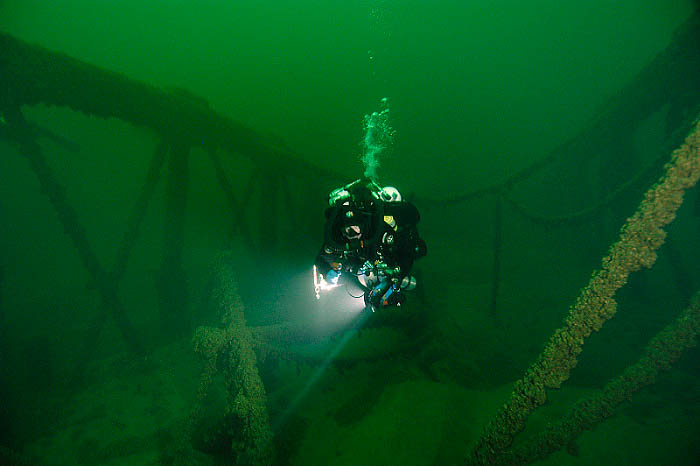“There are around 2000 accidents/shipwrecks in Lake Erie,” said Carrie Snowden, Archaeological Director of the National Museum of the Great Lakes. “Of these, there is probably 800 to 1000 that remain in the lake.” One of these shipwrecks is the Acme Propeller.
Built-in 1856, the Acme was a steam-powered hogging arched package freighter, 190′ in length. She sunk on November 4th, 1867 in a fierce gale. The crew abandoned the ship and survived and Acme landed on the bottom upright in 130′ of water. She was severely silted out overtime and all that remains today are her hogging arches that protrude 10-15 ft above the lake bottom, the very ends of both bow and stern (bow is a bit more intact and stern is just a few planks here and there) and the large engine that is sitting out there in the open.

The ACME left Chicago on the 29th of October and passed Detroit River about 10:30 on the morning of Sunday, the wind being fresh from E.S.E. She passed Point Pelee at 7:00 A.M. on the same day when the wind hauled round to the south. Running under the south shore, smooth water was reached and the vessel began to make headway in company with the propeller NEW YORK, also bound for Buffalo. Steering along this course until 4:00 P.M. on Sunday, smoother water was reached and a lee under the south shore. When about 6 miles off land, opposite Ashtabula, the wind began to blow hard, but the vessel was tight up to 11:30 Sunday night, at which time the wind suddenly shifted to W.N.W., making a very heavy cross sea. The boat commenced labouring badly in the trough of the sea, shipping large quantities of water. At midnight she was rolling and straining terribly, and the exhaust pipe gave way wholly, and the main steam pipe partially, being probably twisted off by the rolling of the vessel.
It was impossible to get more than 20 pounds of steam, and the boat became unmanageable, falling again into the trough of the sea, the water running all through her. All hands were speedily at work at the pumps or engaged in throwing over the cargo, the entire crew labouring as if for life. An attempt was made with the jib to get the boat before the wind, but it failed, and the captain let go his anchors and endeavoured to bring her head to the wind, only however partially succeeding by the aid of the engine. The water soon reached the fires, the wheel stopped and the boat again swung into the trough.
About 8:00 yesterday morning, when off Dunkirk, it became evident that the vessel must go down and the boats were lowered. At 8:58 the water had reached the main deck, and the crew left the doomed ship.
In one boat was Capt. William Dickson and 8 men, in another first mate Valentine Jones, 10 men and a passenger, and the other Jarvis Wiley and several men, 28 in all.
At this time the wind and waves were falling somewhat, and the boats pulled off for shore 15 miles distant. The propeller a few moments later went down stern foremost in deep water. The first boat landed at Dunkirk about noon, another (the Captain’s) 4 miles below Dunkirk, and the other, containing the second mate, at Silver Creek.
The propeller ACME was built in 1856 by Geo. Hardison of this city and was largely repaired in 1863, being in good condition at the time of her loss, and being rated B 1. On the register, she appears as 762 tons burthen. She was owned by the Western Transportation Co., valued at $45,000 and was insured for $33,00.
The cargo of the ACME consisted of 2,274 bbls. flour, 236 bbls. beef, 344 green hides, 26 bdls. sheep pelts, 10 bbls. oil, 70 bgs. timothy seed, 200 tcs. lard and 958 tcs. beef.
During the afternoon, a telegram from Westfield was received in this city, stating that a wreck was lying 6 miles off Barcelona, and 2 miles out in the lake, the crew being on the wreck waving a white flag, as a signal of distress.
Supposing this might mean the ACME, Capt. Dorr telegraphed to the U. S. steamer MICHIGAN at Erie to go to the assistance of the wrecked vessel.
Dunkirk, November 4 – The last boat of the prop. ACME has just arrived, having on board Capt. Dickson and 9 of his crew. The mate of the ACME says that she filled with water in about one hour after they abandoned her.
Detroit Post, November 7, 1867







